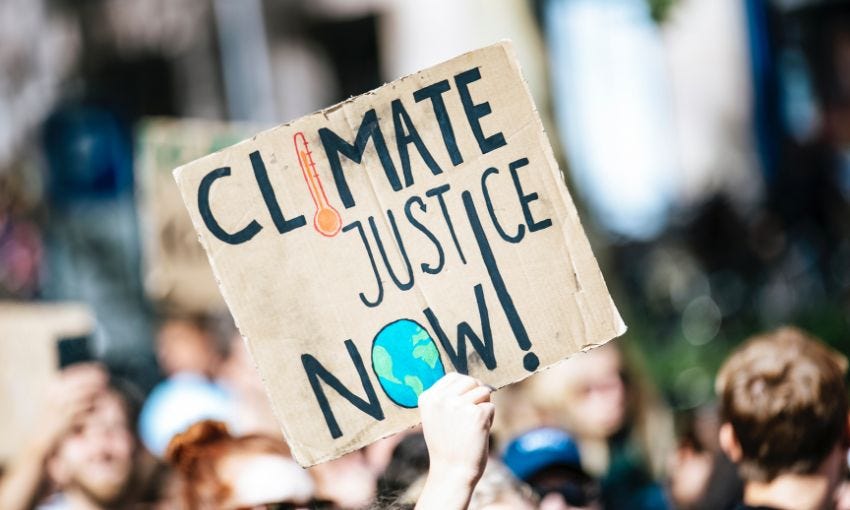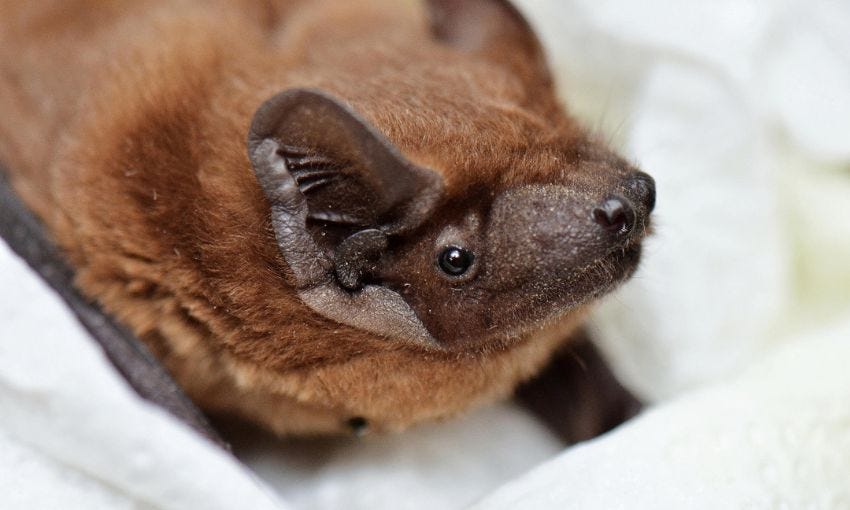Small states with big voices at Cop27
Here’s where to look for climate leadership at Cop27. (Hint: it’s not the major players.)
Kia ora, welcome to Future Proof brought to you by Electric Kiwi.
Cop27 kicked off this week in Egypt, and the speeches on day one were pretty intense. “A highway to climate hell with our foot on the accelerator,” UN secretary-general Antonio Guterres said. “Humanity has a choice: cooperate or perish. It is either a Climate Solidarity Pact – or a Collective Suicide Pact.” Yeesh. Of course this intensity feels warranted when you think about recent climate disasters (floods in Pakistan, heatwaves in Europe and China…) and the fact that the last eight years were the hottest ever on record. Yeesh indeed. Beyond the gnarly speeches and looming shadow of the Russia-Ukraine conflict, here are a couple of Cop27 themes you should keep an eye on. (For a detailed rundown of the Cop27 goss, the New York Times has an unpaywalled update.)
A whole lot of hot air?
It can feel like these global climate gatherings are a whole lot of hot air. Tens of thousands of people fly across the world every year to hash out agreements that never seem to go far enough, quickly enough in a “nightmarish process”. They’re characterised by “a certain optimism and excitement before they begin and disappointment after they close,” two researchers write on The Conversation. So where can we find inspiration and leadership-in-action instead? I was struck by this comment from political scientist Professor Bronwyn Hayward: “If we are not to waste the precious time we have to make a difference for a safer climate future, it will be leadership by ordinary people, Indigenous communities, Small States, businesses and the Global South, who understand the extraordinary climate risks we now face, that will create the real lasting momentum for change.”
Small states and Global South are pushing for loss and damage compensation
Countries vulnerable to climate change have long asked those countries that have generated the bulk of emissions to compensate them for damage caused – the principle of “polluter pays” in action. At this summit, those requests have turned into demands – and after some wrangling, the loss and damage idea is on the agenda for negotiation. The prime minister of the Caribbean island nation of Antigua and Barbuda, Gaston Browne, also called for Big Oil to pay its fair share for causing climate damage: “The oil and gas industry continues to earn almost 3 billion United States dollars daily in profits. It is about time that these companies are made to pay a global carbon tax on their profits as a source of funding for loss and damages. New Zealand has offered $20 million towards climate damages today – but it’s not a new tranche of cash, having been reallocated from a $1.3 billion fund announced last year.
Adapting to the climate crisis is also up for discussion
Loss and damage aren’t the only areas in need of funding among vulnerable nations. As climate change impacts accelerate, countries are looking to adapt, and they’re looking for funding to help them do so. Fiji has a detailed plan to shift communities out of harm’s way as sea levels rise, but finding resources to implement the plan has proved tricky. Kate Lyons from The Guardian has an excellent long read on Fiji’s relocation plans, and how it’s going.
In other adaptation news, the UN has unveiled a plan calling for $3.1 billion to implement universal early warning systems for climate-related disasters. Such disasters already displace three times more people than war. Early warning systems integrate monitoring and forecasting with risk assessments, preparedness and communication. The end result is that communities are equipped with the knowledge they need to deal with climate disasters like floods.
Want to support the green energy transition?
The best thing you can do is shift your power usage away from the peak periods. Better still, it’ll save you money too.The Electric Kiwi MoveMaster plan has cheaper off-peak rates, and any power used overnight (11pm-7am) is half price, giving you the perfect incentive to shift your power usage as much as possible. Generally, less carbon is created to generate electricity at night, so you can be confident the power you’re using comes from renewable sources.
See what you could save with MoveMaster today.
We can’t rely on planting trees to offset carbon emissions
I’ve said it before and I’ll say it again: we can’t plant our way out of this climate mess. In fact, under current pledges, we’d need 1.2 billion hectares of land for carbon removal projects. That’s an area larger than the entire US. Seems a bit sus. Here in New Zealand, the pine planting frenzy continues. Stuff’s Olivia Wannan reports on an analysis from Beef + Lamb suggesting that some 50,000 hectares of farmland bought over the last year is now destined to be carbon-offsetting pine forest. And while we’re here, no, we can’t just treat the ocean as one giant carbon sink in our emissions accounting, as leader of the opposition Christopher Luxon appeared to suggest.
Massive carbon footprint of military missing from global emissions accounting
The world’s armed forces generate a lot of climate pollution – some estimates suggest military emissions are on par with the global aviation or shipping industries – but we really don’t know how big this problem is. A comment in the scientific journal Nature calls for this to change, so we can get our global carbon accounting in the right ballpark.
Good news for rivers
The Environment Court has recommended that the Ngaruroro River in Hawke’s Bay should be subject to a Water Conservation Order, which provides protections such as prohibition of dams, water quality minimums and limits on alterations to the flow of the river. Forest & Bird, one of the organisations that lodged the application for protection, have also released a “Room for Rivers” proposal – basically, giving rivers space to roam as rivers are wont to do – offering one way to adapt to increased flooding with climate change. This concept was covered in The Bulletin in August.
Meanwhile in Taranaki, tree planting, weed control and pest trapping by hapū are transforming the Waiwhakaiho River mouth. All this aroha for our awa – you love to see it!
Coal is making a comeback?!
We don’t need any more fossil fuels. We have enough in current reserves to meet demand as we roll out renewable energy – and the government is continuing to issue new fossil fuel exploration permits, Stuff’s Olivia Wannan reports. Meanwhile, at Cop27, activists are asking governments to promise an end to all new oil, gas and coal projects through a “fossil fuel nonproliferation treaty”. But as the Russia-Ukraine war continues to squeeze global energy supplies, some countries are turning back to a bad habit: burning coal for power.
The stories we tell about climate change and the environment matter. I've been writing The Spinoff's weekly Future Proof newsletter since July, sharing hopeful but honest news about the climate and our natural world. It's rewarding work – showcasing the people, mahi and solutions that will help us navigate the climate crisis.
I feel so lucky to have a dedicated space to connect with readers like you, where we can kōrero with hope instead of doom and gloom. Too often newsrooms and media publications relegate environment and science to the sidelines, but through Future Proof, The Spinoff is giving te taiao the attention it deserves.
If you care about empowering climate and environmental journalism grounded in evidence, please support our work by donating today.
More stories
A new study in Britain finds that 60% of so-called “home compostable” packaging items fail to disintegrate within six months.
Centuries-old whaling logbooks are helping scientists track our changing climate.
Mystery behind kākāpō fungal infection pandemic solved.
This new material could be a game-changer for carbon capture and storage.
Climate on film: storylines beyond the apocalyptic could help us cope with the climate crisis, and even change our behaviour.
Could this ancient technique for growing grains be part of our sustainable farming future?
Mussel restoration stations using woven cabbage tree ropes have increased mussel populations in this Bay of Plenty harbour.
How can you resist this adorable face? A common noctules bat rescued in Ukraine. Image credit: Ukrainian Bat Rehabilitation Center.
To end this edition: two stories about helping bats. The first comes from Ukraine, where bat rescue and rehabilitation efforts are continuing despite the ongoing war. The scientists behind the Ukrainian Bat Rehabilitation Center have performed rescue missions for bats trapped in bombed buildings, and endured accusations from the Russian propaganda machine that they’re deploying bats with bioweapon infectious diseases. And still, the bat team has continued their conservation efforts.
A bit closer to home, this nationally critical pekapeka-tou-roa / long-tailed bat was attacked by a pet cat back in late July. After three months of care at Hamilton Zoo, this lovely little lady recovered from her injuries and was released into the night on Monday.
Fly free,
Ellen
Got some feedback about Future Proof or topics you’d like covered? Get in touch with me at futureproof@thespinoff.co.nz













